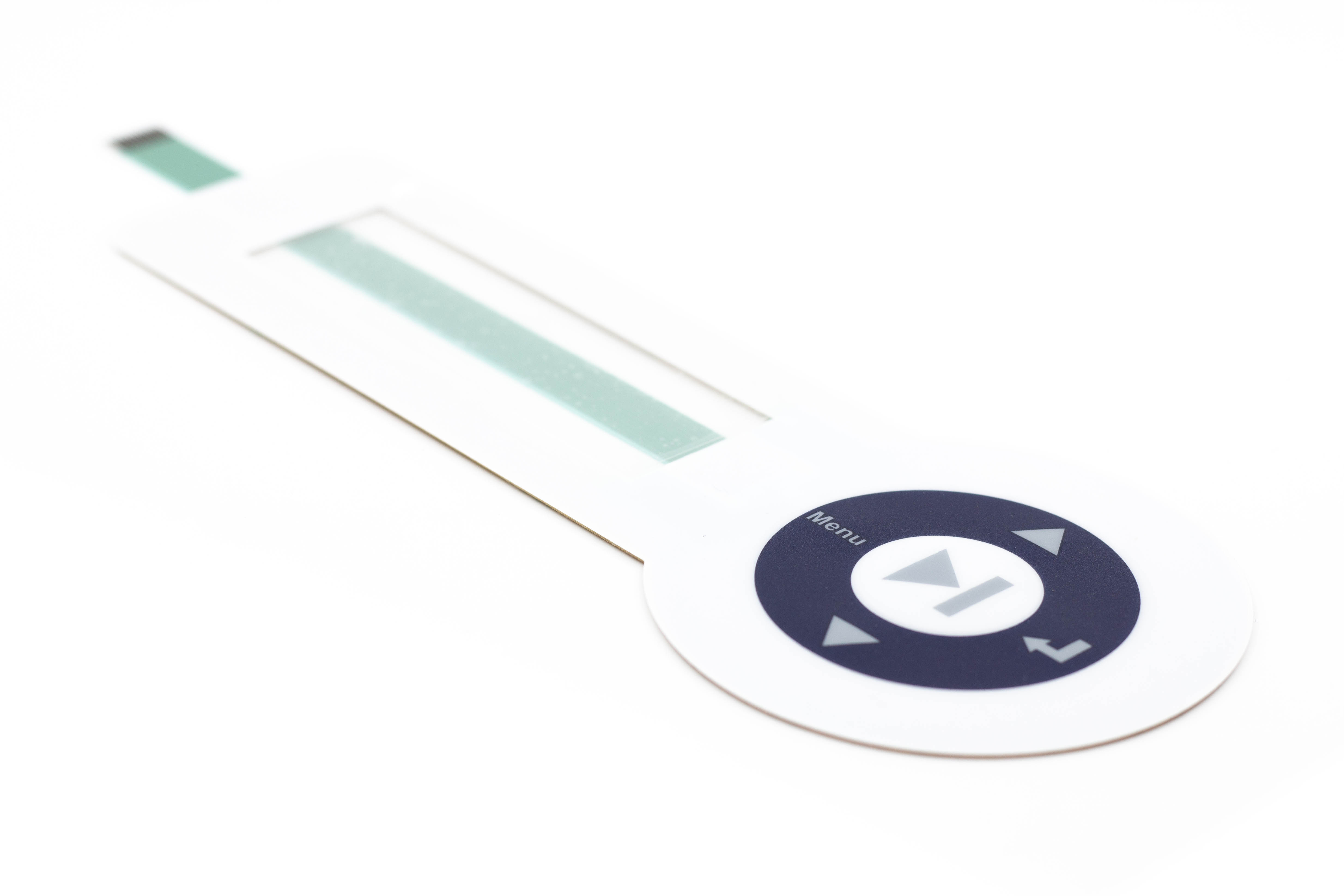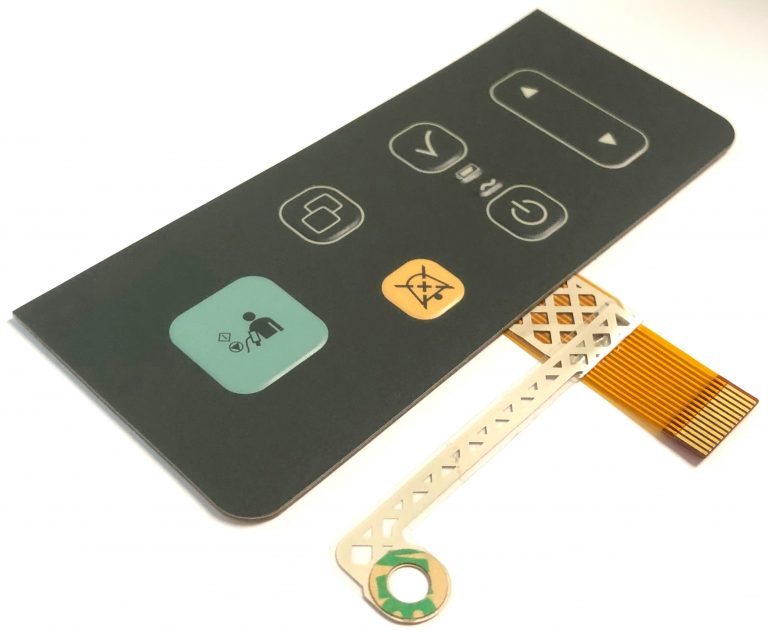Everything About Membrane Switch: A Comprehensive Guide for Beginners
Membrane layer switches are necessary parts in modern electronic devices, offering a distinct interface for individual communication - membrane switch. Their layered building and construction, including overlays and conductive traces, supplies performance and durability. Unlike typical mechanical switches, membrane layer buttons provide a sleek style and customizable choices. Understanding their key functions and benefits can change product style. The complexities of their application and style considerations require further exploration.
What Is a Membrane layer Switch over?
A membrane button is a kind of electric switch that contains a versatile membrane layer layered over a published circuit card. This layout enables for a portable and smooth user interface, often utilized in various electronic devices. Membrane switches are commonly located in customer devices, medical devices, and industrial equipment because of their sturdiness and resistance to ecological factors.The construction normally consists of several layers, such as graphic overlays and adhesive backing, which supply responsive comments and safeguard the wiring beneath. The operation of a membrane switch is started when stress is put on the surface, finishing an electrical circuit.These buttons are valued for their versatility, enabling custom designs and printed graphics that satisfy certain user interfaces. Their low-profile nature minimizes area needs, making them optimal for applications where typical buttons may not fit. On the whole, membrane layer buttons offer a aesthetic and practical remedy for modern-day digital devices.
Secret Elements of Membrane Layer Switches Over
Membrane changes comprise a number of key components that contribute to their performance and efficiency. The leading layer, called the overlay, gives the user interface and is commonly printed with graphics or icons. Under the overlay exists a spacer layer, which divides the conductive components and stops unintentional activation. The following crucial component is the visuals layer, which boosts aesthetics and ensures the durability of the design.Conductive traces, typically made from materials like silver or carbon, are printed on the circuit layer. When pressure is related to the overlay, these traces come into get in touch with, finishing the circuit. Furthermore, a backing layer provides architectural assistance and can be made from materials such as polyester or polycarbonate. With each other, these elements produce a trustworthy, straightforward user interface ideal for various applications, from household home appliances to commercial devices. Comprehending these elements is vital for any individual interested in membrane button innovation.
Exactly How Membrane Layer Changes Job
Comprehending exactly how membrane changes function is necessary for appreciating their widespread use in various devices. A membrane layer button operates with a collection of layers, including a visuals overlay, spacer, and a circuit layer. When pressure is put on the overlay, it compresses the spacer layer, allowing the circuit layer to make contact and complete an electric circuit. This activity sends out a signal to the tool, triggering an action, such as activating a light or triggering a function.Membrane switches can be designed with various features, including tactile comments, backlighting, and custom-made graphics, improving user communication. Their building enables for a covered design, protecting the internal elements from dust, wetness, and contaminants. This resilience makes them ideal for diverse applications, from customer electronic devices to commercial devices. Generally, the simpleness and performance of membrane switches over add to their appeal in contemporary technology.
Advantages of Membrane Switches Mechanical Buttons
While mechanical buttons have long been a staple in lots of gadgets, membrane switches over deal unique advantages that make them increasingly appealing. One considerable advantage is their slim account, allowing for even more portable styles and higher versatility in product development. Furthermore, membrane changes attribute an uniform surface area, which enhances visual appeal and streamlines cleaning, making them appropriate for environments where hygiene is critical.Another advantage is their resistance to dirt and wetness. Unlike mechanical switches, which can be endangered by environmental aspects, membrane layer switches give a sealed interface that protects versus impurities - membrane switch. Membrane buttons generally have a longer life expectancy due to fewer moving components, resulting in boosted toughness and reliability.Cost-effectiveness is likewise a notable benefit, as membrane buttons can be created in bulk with lower production costs. These factors incorporate to place membrane layer switches as a sensible choice to conventional mechanical alternatives in numerous applications
Usual Applications of Membrane Layer Changes
Membrane switches are commonly used in numerous industries, specifically in consumer electronic devices and commercial control board. In customer gadgets, they supply a streamlined, user-friendly interface, while in industrial setups, they boost toughness and performance. Recognizing these applications highlights the flexibility and usefulness of membrane layer switches in contemporary technology.
Consumer Electronic Devices Gadgets
As customer electronics remain to develop, membrane layer buttons have actually ended up being a popular option for a range of devices as a result of their adaptability and streamlined design. These switches are commonly found in mobile phones, tablets, and remotes, where area is restricted and appearances issue. Their low profile and personalized styles enable producers to create easy to use interfaces that improve the general customer experience. Furthermore, membrane layer buttons are commonly made use of in devices such as microwaves and coffee machine, giving instinctive control options while standing up to moisture and dust. The durability and dependability of membrane layer changes make them suitable for everyday customer products, making sure durability and regular efficiency. On the whole, their integration in consumer electronic devices reflects a mix of functionality and modern layout.
Industrial Control Panels
The applications of membrane switches over prolong past customer electronics, finding significant use in industrial control panels. These buttons are preferred for their longevity and resistance to harsh settings, making them excellent for manufacturing and procedure control settings. They look at here supply a reputable interface for drivers to regulate machinery, screen procedures, and change setups. Membrane layer switches can be personalized to suit certain operational requirements, integrating attributes like backlighting and tactile responses, boosting individual experience. Their inconspicuous design allows for integration right into various devices, while their capacity to withstand spills, dirt, and severe temperature levels assurances long life. Overall, membrane switches contribute to reliable and secure operation in industrial applications, showing their flexibility and efficiency in demanding environments.
Considerations for Creating Membrane Layer Switches
When developing membrane layer switches, selecting the appropriate products is necessary to assure toughness and functionality. Additionally, understanding layer arrangement techniques can considerably influence the button's see page performance and individual experience. These considerations play a vital role in developing reliable and dependable membrane button designs.
Material Selection Relevance
Product selection plays a vital duty in the design and capability of membrane layer buttons. The selected materials directly impact the switch's sturdiness, tactile action, and general visual. Trick factors to consider include the substratum, which must supply structural stability while allowing for flexibility, and the visuals overlay, which requires to be immune to wear and environmental factors. Conductive materials ought to ensure reliable electric efficiency, while adhesives have to use strong bonding without jeopardizing the button's operation. In addition, compatibility with producing processes and end-user settings is essential; products must stand up to varying temperatures, moisture levels, and chemical direct exposure. Ultimately, proper material option not just boosts the membrane switch's performance however likewise contributes to its durability and individual contentment, making it a vital element of the design procedure.

Layer Configuration Methods

Frequently Asked Questions
For How Long Do Membrane Layer Changes Normally Last?
Membrane layer buttons generally have a life-span of 1 to 5 million cycles, depending on usage and environmental problems. Elements such as layout quality and operating frequency considerably affect their resilience and general efficiency durability.

Can Membrane Layer Changes Be Customized for Details Designs?
Membrane layer switches can certainly be customized to suit certain layouts, permitting for varied shapes, shades, and capabilities. This versatility makes it possible for manufacturers to tailor these buttons to fulfill one-of-a-kind visual and functional demands successfully.
What Materials Are Used in Membrane Switch Over Building?
Membrane layer switches are typically created making use of products such as polyester, polycarbonate, and sticky layers. These materials provide flexibility, resistance, and sturdiness to environmental factors, making sure the buttons operate efficiently in different applications and problems.
Are Membrane Switches Waterproof or Immune to Moisture?
Membrane layer buttons can be designed to be moisture-resistant, utilizing specialized materials and finishings. Their water-proof capabilities depend on construction quality and details applications, making it important to evaluate demands for optimal performance in numerous environments.
How Are Membrane Changes Fixed if Harmed?
Repairing damaged membrane switches over generally includes replacing the impacted layer or circuit. Professionals may likewise use conductive glue or utilize specialized fixing packages, guaranteeing functionality is recovered without complete substitute of the entire switch assembly. Unlike traditional mechanical switches, membrane layer buttons provide a smooth design and customizable choices. A membrane switch is a kind of electrical switch that is composed of an adaptable membrane layer layered over a published circuit board. The operation of a membrane switch is initiated when stress is used to the surface, completing an electric circuit.These switches are valued for their flexibility, enabling customized designs and printed graphics that provide to details individual interfaces. While mechanical switches have long been a staple in lots of devices, membrane changes offer distinct advantages that More Bonuses make them significantly appealing. Membrane buttons generally have a longer life expectancy due to less moving components, resulting in improved resilience and reliability.Cost-effectiveness is additionally a remarkable advantage, as membrane layer buttons can be created in bulk with lower manufacturing costs.